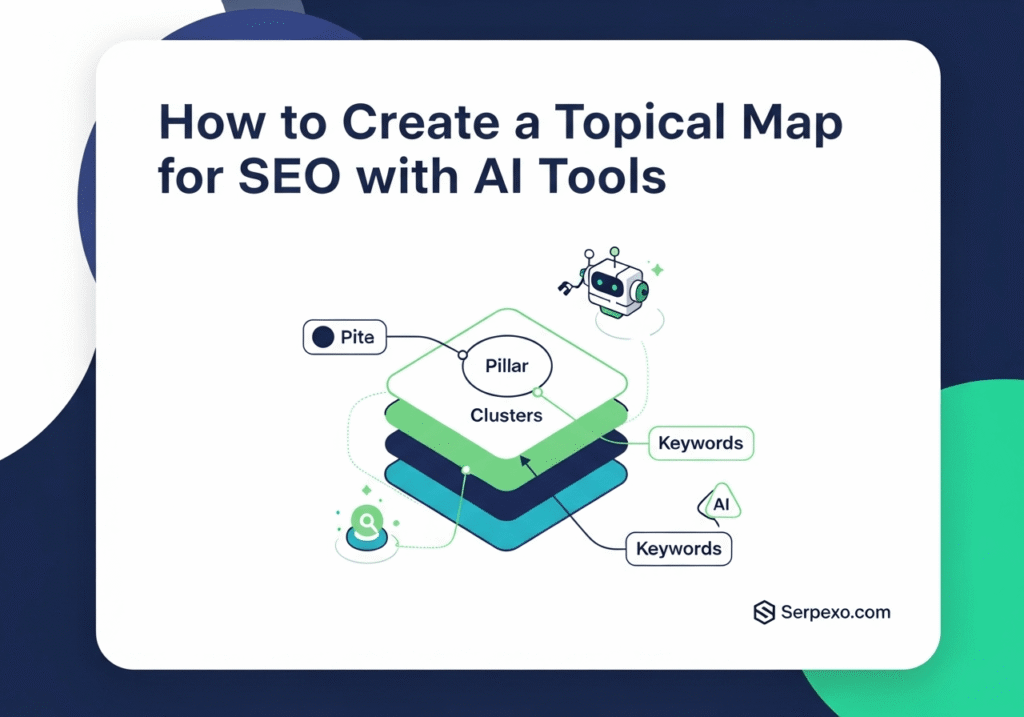
AI-Driven Topical Maps: Revolutionizing Your SEO Strategy
In the constantly changing landscape of search engine optimization, the factor that separates appearing on the first page from fading into the digital background often boils down to one key element: authority. Google now goes beyond simple keyword matching to grasp entire concepts and acknowledge true expertise. This is where a topical map emerges as your most powerful strategic tool.
If you’re prepared to advance past the pursuit of individual keywords and aim to establish genuine topical authority, this guide is tailored for you. We’ll dive into the steps to create a thorough SEO topical map from the ground up, utilizing the remarkable speed and insights offered by AI tools. This approach will revolutionize your content strategy into a cohesive plan, boosting your rankings and positioning your site as a trusted resource.
Understanding SEO Topical Mapping
A topical map serves as a detailed and organized framework for your website’s content, centered around a primary subject. It systematically lays out your central topic, known as the pillar, branching into various related subtopics, referred to as clusters, and further into detailed questions that act as supporting content ideas. Rather than having a random assortment of articles, a topical map enables you to curate a well-connected network of information, ensuring comprehensive coverage of the subject area.
This approach to semantic organization aids search engines like Google in understanding the broad range and intricate depth of your expertise. It reveals the connections between the diverse pieces of content you generate and highlights the overall value your website provides to users. By establishing these relationships, search engines can better recognize the authority and relevance of your content within its topical framework, enhancing your site’s visibility and ranking in search results.
Why Building Topical Authority is Important?
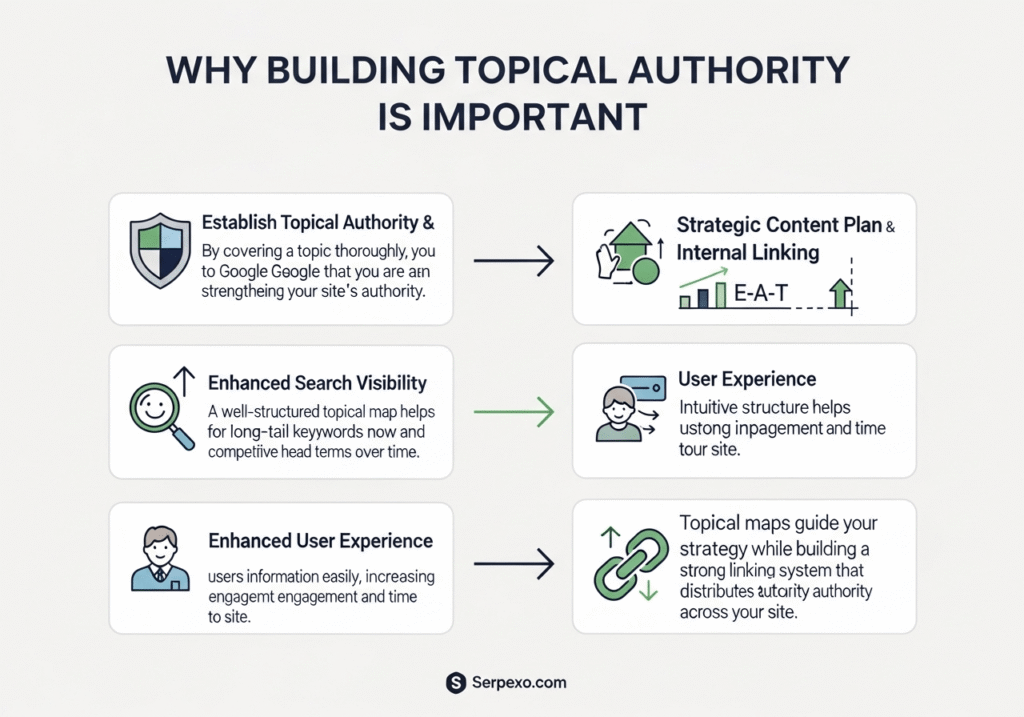
The main aim of a topical map is to establish topical authority. By thoroughly covering a subject and addressing every potential question a user might ask, you strongly convey to Google that you possess expert knowledge. This approach is fundamental to showcasing Expertise, Authoritativeness, and Trustworthiness (E-A-T), which are critical criteria in Google’s content ranking algorithm.
The advantages of implementing a topical map approach within your SEO strategy are significant and far-reaching:
- Enhanced Search Visibility: By developing a well-organized topical map, you improve your chances of ranking for a broad spectrum of long-tail keywords. Over time, this strategic approach also positions you to compete for the more challenging and competitive head terms, thus boosting your site’s presence in search engine results.
- Enhanced User Experience: A topical map provides an intuitive and well-organized structure that allows users to seamlessly navigate through your website. It helps them quickly locate the information they seek and encourages them to delve deeper into associated topics. This improved navigation not only boosts user engagement but also increases the amount of time visitors spend on your pages, ultimately leading to a more satisfying experience.
- Strategic Content Plan: It offers a well-defined, data-informed guide that removes uncertainty, allowing you to pinpoint and address significant content gaps with precision.
- Enhanced Internal Linking Strategy: The structured framework of the topical map inherently guides the development of a robust internal linking system. This approach strategically distributes page authority throughout your website, ensuring that each page contributes to the overall SEO strength of the site.
What are the Essential Components of a Topical Map for SEO with AI Tools ?
To develop a robust topical map, it’s crucial to comprehend its hierarchical structure, which is composed of three main layers:
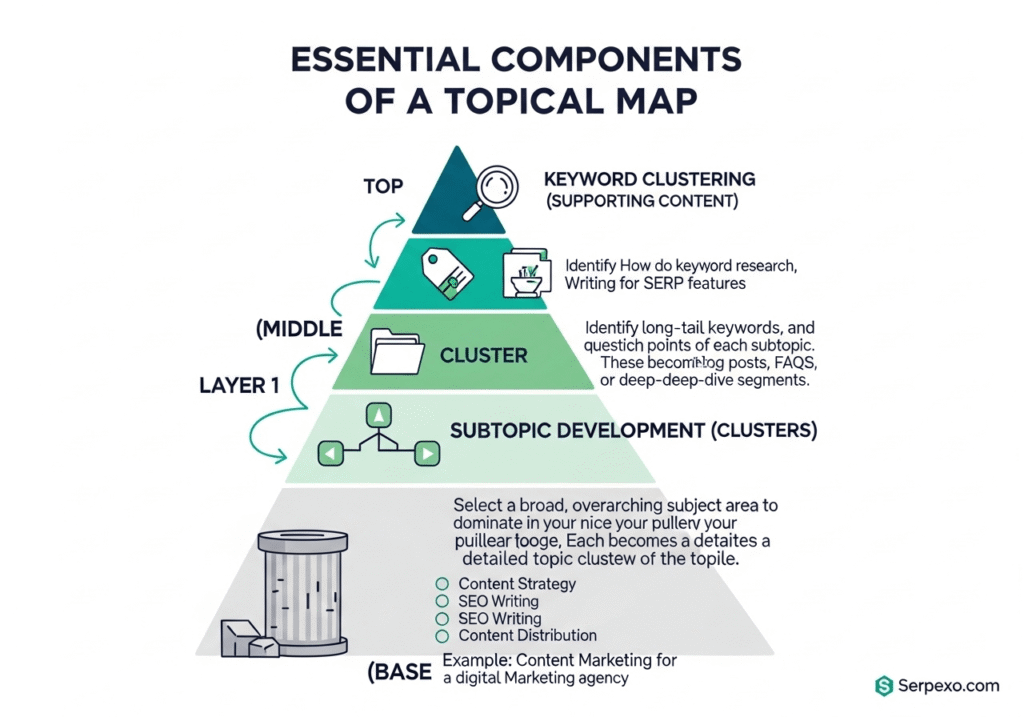
- Core Topic Identification (The Pillar pages): This stage involves selecting a broad and overarching subject area that you aim to dominate within your niche. It acts as the cornerstone of your topical map and is generally illustrated by an extensive and detailed “pillar page.” This page provides a thorough overview of the topic from a high-level perspective. For instance, if you run a digital marketing agency, your core topic could be “Content Marketing,” where you explore all facets and insights related to the subject comprehensively.
- Subtopic Development (The Clusters): These represent the significant themes that extend from your central topic. Each subtopic evolves into a “topic cluster,” represented by a comprehensive and detailed article. For example, in the “Content Marketing” pillar, subtopics could encompass themes like “Content Strategy,” “SEO Writing,” and “Content Distribution.
- Keyword Clustering (The Supporting Content): This represents the most detailed and specific level within the topical map. It includes individual questions, long-tail keywords, and in-depth points directly relevant to each overarching subtopic. The content produced here often manifests as blog posts, FAQ sections, or specialized segments within a broader cluster article. For instance, within the “SEO Writing” cluster, you might have keyword clusters such as “how to do keyword research,” focusing on strategies and tools, or “writing for SERP features,” which delves into optimizing content to appear in rich snippets or answer boxes.
Tools for AI-Driven Topical Mapping
AI technology has significantly accelerated and enhanced the data-driven process of creating topical maps for SEO. Utilizing AI-driven tools, you can quickly analyze search engine results pages (SERPs), common user queries, and competitor content to generate a detailed and comprehensive content outline in just a matter of minutes.
- Comprehensive SEO Platforms: Tools such as Surfer SEO and MarketMuse come equipped with advanced features designed to analyze search engine results pages (SERPs). These platforms provide invaluable topic and keyword suggestions based on the current digital landscape. They excel at pinpointing what your competitors are focusing on within their content and highlighting areas where your content might be lacking or could be expanded further.
- Specialized Topical Map Creation Tools: Platforms such as Agility Writer and Logicballs’ Free AI SEO Topical Map Generator are tailored specifically for creating topical maps. These tools allow you to input a primary topic, upon which the AI efficiently crafts a well-organized map featuring various clusters and valuable content suggestions. This process significantly reduces the time and effort required for manual research, offering actionable insights and structured content plans in a matter of moments.
- Generative AI, like ChatGPT, can serve as a potent brainstorming ally when given a thoughtfully designed prompt, allowing you to explore various creative ideas and insights.
Prompt Example: “Act as a semantic SEO expert. Create a detailed topical map for the core topic ‘sustainable home gardening’. Organize the output into a hierarchical structure with a main pillar topic, at least 5 subtopic clusters, and 5-7 specific long-tail keyword ideas for each cluster.”
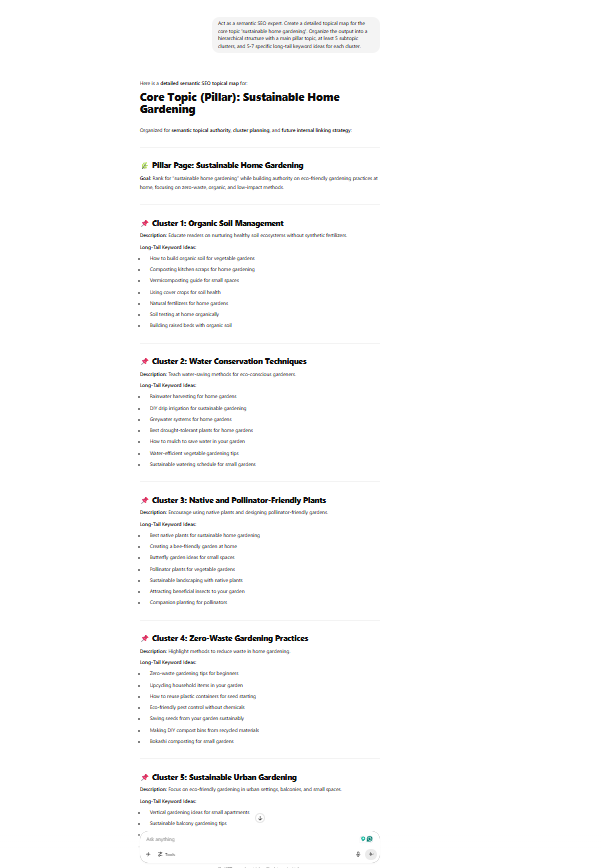
How to Create an SEO Topical Map with AI-powered tool
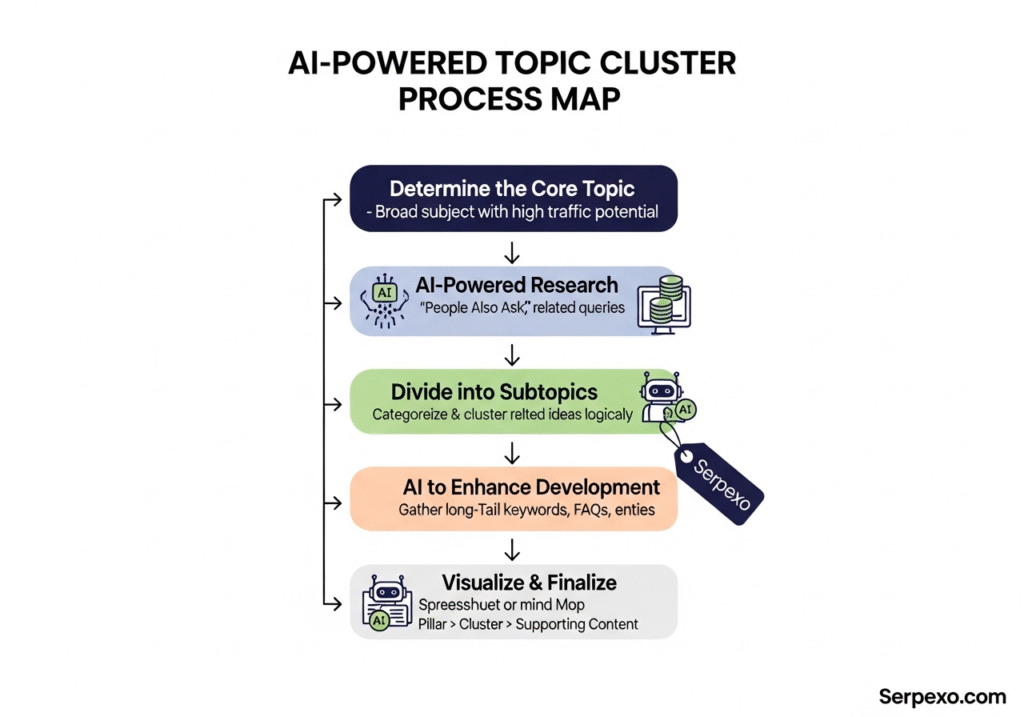
- Determine the Core Topic: Begin with a broad subject that is pivotal to your business and promises significant traffic potential.
- Conduct Initial AI-Powered Research: Input your main topic into your chosen AI tool. Let the AI analyze SERPs, “People Also Ask” sections, and related search query data to generate a raw list of potential subtopics and keywords.
- Divide the Main Topic into Subtopics: Carefully evaluate the output provided by the AI tool. Utilize your expertise to categorize related ideas into coherent subtopic clusters, ensuring that they are logically connected. Eliminate any information that is not pertinent to the main topic. Arrange these clusters thoughtfully to create a clear and cohesive structure that facilitates understanding for someone exploring the subject.
- Utilize AI to Enhance Topic Development: Once you’ve identified your subtopic clusters, input each one into your AI tool to delve deeper into the content creation. Request detailed long-tail keywords, frequently asked questions, and associated entities. This method helps you expand your topical map to its most detailed and comprehensive level.
- Visualize and Finalize: Arrange your completed topical map in either a spreadsheet or a mind mapping tool for clarity and accessibility. Establish a definitive hierarchy by structuring it as follows: Pillar Topic > Subtopic Clusters > Supporting Content Pieces. This visual representation serves as your official and actionable content plan.
Enhancing Content Planning and Internal Linking
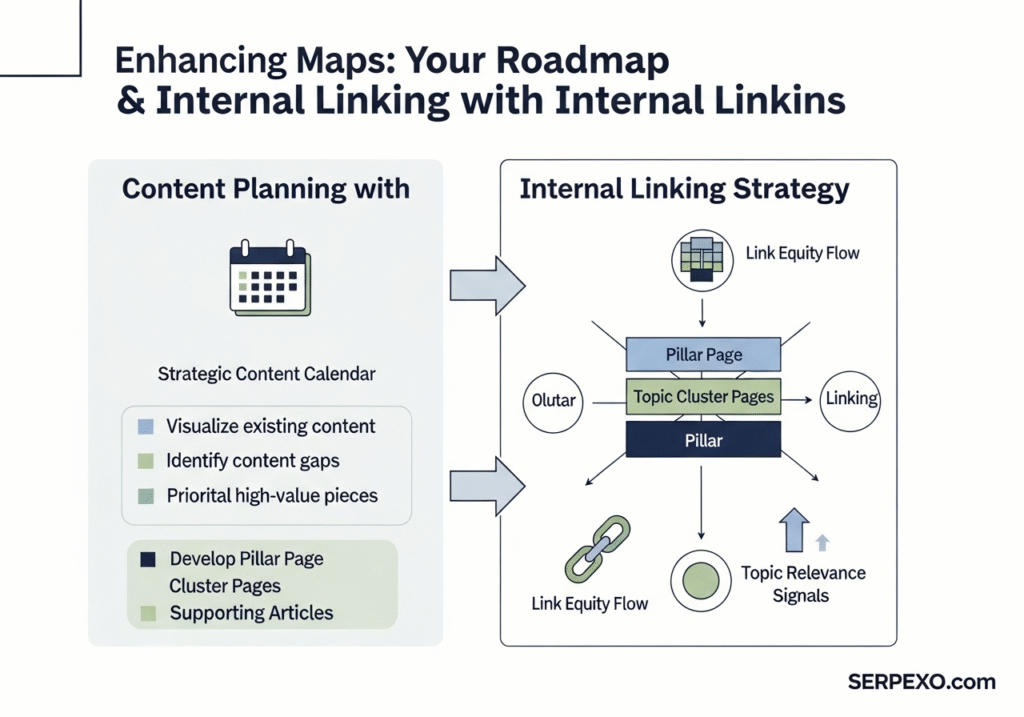
A topical map is not just a research document; it is an actionable strategy. Its two most powerful applications are in content planning and internal linking.
First, the map serves as your content calendar. You can immediately see the content you have and, more importantly, the content gaps you need to fill to establish authority. Prioritize creating your pillar page and your main cluster pages first to build a strong foundation.
Second, the map provides a perfect, logical blueprint for your internal linking strategy.
- Every supporting article should link up to its parent topic cluster page.
- Every topic cluster page should link up to the central pillar page. This hub-and-spoke model is incredibly effective for signaling topic relevance to search engines and flowing link equity to your most important pages.
Monitoring and Refining Your Topical Map
Creating your topical map is only the beginning. To sustain your search rankings and continue to build your authority, it’s essential to view your topical map as a dynamic, ever-evolving document.
- Evaluate Performance Metrics: Leverage tools such as Google Search Console to assess how effectively your topic clusters are performing. Pinpoint which pages generate the most traffic and identify those that lag behind. Use these insights to guide your content update and optimization.
- Maintain SEO Relevance: It’s advisable to reassess and update your topical map on a regular basis, ideally every three to six months. This is crucial because search trends are constantly evolving, and new questions or topics could arise in your niche at any time. By employing your AI tools to periodically conduct research on your main topic, you can uncover fresh and pertinent subtopics to incorporate into your map. This proactive approach ensures your content remains current and engaging, never becoming outdated or irrelevant.
What is a topical map in SEO?
A topical map is a strategic framework that arranges your website’s content around a core theme. It establishes a hierarchy of a central topic (pillar), associated subtopics (clusters), and corresponding articles, aiding in showcasing thorough expertise to search engines.
How do topical maps help in rankings, improve seo performance and search visibility?
Topical maps enhance rankings by positioning your website as a subject authority. By providing in-depth coverage, they signal expertise to Google, enabling your site to rank for a wider variety of keywords. This strategy boosts overall search visibility and attracts increased organic traffic.
Why do you need a topical map?
A modern and effective SEO strategy hinges on the creation of a topical map. This valuable tool offers a well-defined content plan and ensures thorough coverage of any given topic. Furthermore, it enhances user navigation and establishes a robust internal linking structure, all of which are essential components that influence search engine rankings positively.
Can I use topical map AI tool to create a topical map?
Certainly! AI tools are perfectly suited for developing topical maps. They have the capability to swiftly sift through vast volumes of search data, pinpointing relevant topics, subtopics, and user inquiries in just minutes. This makes the process much quicker and more data-centric compared to traditional manual approaches.
Can I use ChatGPT to create topical maps?
Certainly, ChatGPT is a fantastic resource for creating a foundational topical map. By providing it with a detailed and specific prompt, you can have it draft a thorough structure comprising pillars and clusters, which you can then further refine and develop.
What is the best AI topical map generator?
The “best” tool depends on your specific needs and budget. Top options include:
- All-in-one platforms like Surfer SEO or MarketMuse for deep analysis.
- Specialized generators like Agility Writer for speed and efficiency.
- Free tools like Logicballs’ AI Generator for those starting out.
How often should I update my topical map?
A topical map for SEO should be considered a dynamic, evolving document. It is a best practice to review and refresh it every three to six months. This regular update cycle enables the inclusion of new and emerging subtopics and questions. By doing so, you ensure that your content stays fresh, relevant, and authoritative in the ever-changing online landscape.

One Response